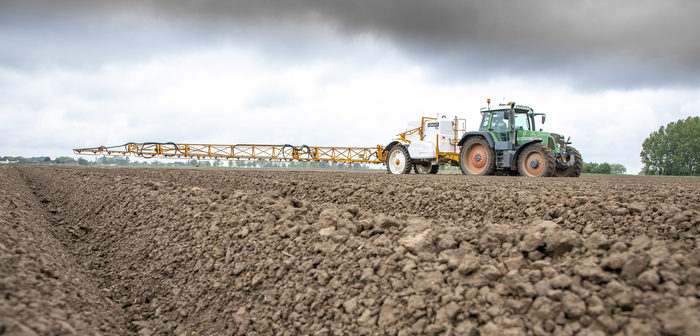Potato growers may need to rethink their usual reliance on pre-emergence herbicides this year after a period of dry weather.
While planting has progressed well thanks to favourable conditions, the dry soils will have a negative impact on the efficacy of the pre-emergence weedkillers typically applied to ridges shortly after planting. Corteva Agriscience field technical manager Craig Chisholm says leaving weeds unchecked can reduce yield, slow down harvesting machinery and increase the risk of blight.

“Dry soils can crack or slip down the ridges, disrupting the all-important seal required for optimum efficacy from pre-emergence herbicides. As a result, rain or planned irrigation in the next few weeks will stimulate weed growth from the ridge surface and from depth,” Craig says.
Dry conditions compromise efficacy
“Dry conditions in unirrigated fields and disruption to the herbicide ‘barrier’ means that the efficacy of pre-emergence chemistry will be compromised. This could well be a year when growers need to think about following up with a post-emergence spray.”
Titus®, containing the active ingredient rimsulfuron, is a valuable herbicide which targets key problem weeds and is an invaluable tool in a dry season when pre-emergence activity will be negatively affected. The selective herbicide has been a mainstay of potato growers’ early-season programmes to control a wide range of broadleaf weeds including cleavers, chickweed, redshank, mayweed and oilseed rape volunteers. Titus has also demonstrated excellent activity on a range of grasses, notably couch.
Well known qualities
“The qualities of Titus are well known to UK and Irish potato growers and agronomists and with fewer options available for weed control, it will become an ever-more important tool,” says Craig. “Titus should be applied when broad-leaved weeds are small and actively growing, typically cotyledon to four leaves, and grasses pre-tillering (two-to-three leaves), and before crop sheltering can impact herbicide coverage.
“It is suitable for use on all potato varieties excluding seed crops and is compatible with metribuzin, which will further broaden the weed spectrum in potato varieties which are tolerant to post-emergence application.” Titus should be applied at 50g/ha when applied alone or 40-50g/ha in mix with metribuzin, and always used with an approved adjuvant.
Greater use of natural regeneration breaks and cover crops in arable rotations means the weed seed burden of some of the more troublesome weeds for potatoes are on the increase. Cleavers, mayweed and shepherd’s purse, for example, can proliferate rapidly in a single season. Potato growers feeling the pinch of price pressures this spring could look at simplifying herbicide mixes for more cost-effective pre-emergence options, advocates Syngenta Technical Manager, Andy Cunningham.
“Recent potato herbicide introductions have increased agronomists’ options. In many instances, however, simple mixes can achieve everything growers want, at lower relative cost,” he suggests. “Many of the key weeds that burden early potato emergence can be controlled, using the strength of mixes to widen the specific weed spectrum,” he advised.

Recent season’s trials had shown a mixture of Defy (prosulfocarb) at 4.0 l/ha + metabromuron at a reduced rate of 1.0 l/ha, for example, achieved full control of assessed broad-leaved weeds, including chickweed, mayweed, cleaver and shepherd’s purse. Untreated weed pressure from these species was more than 70 per m2. That combination, typically costing just £43 per hectare at current prices, was even more effective overall compared to Defy at 3.0 l/ha and metabromuron at a rate of 2.0 l/ha, which would cost nearly £55/ha and proved slightly weaker on cleavers.
Using Defy at 4.0 l/ha plus metribuzin at 0.5 l/ha could also reduce costs, but the trial showed that overall effects on some weeds could be reduced. “It is important to know the target weed spectrum when putting together mixes of the most cost-effective actives and appropriate rates,” advised Mr Cunningham.
Control of grass weeds
As well as the wide spectrum of broad-leaved weeds controlled by Defy, it also offers control of grass weeds including meadow grasses and ryegrass. Using a higher rate extends the residual activity and means applications can be conveniently made soon after planting, until soil is rising over emerging potato shoots, to keep fields clean through to crop emergence.
New Syngenta potato trials for the 2022 season are set to investigate the extra benefit of total weed spectrum control from increasing Defy rates to 5.0 l/ha, at marginal extra cost in a high-pressure situation, as well as mixes with new and existing herbicides. “Some options with newer herbicides in the trial add up to in excess of £100 per hectare, with others as low as £20. It’s vital to tease out what each component is contributing, to enable better informed decisions in the future,” he added.
Weed multiplication
One shepherd’s purse plant, for example, can produce over 3000 seeds, and is capable of cycling three generations in a season if left uncontrolled. The seeds are long-lived and will emerge quickly when brought to the surface by potato seedbed cultivations. “Growers should also be aware that shepherd’s purse is a host for white blister, which can be spread to brassica crops if they are grown in the rotation,” warned Mr Cunningham. Although seen as relatively easy to control, the burden and the costs of control are rising.


